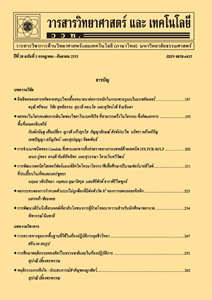ประสิทธิภาพของราเอนโดไฟท์ในการยับยั้งเชื้อสาเหตุโรคไหม้ของข้าว
Main Article Content
Abstract
Abstract
This research aimed to investigate the potential of fungal endophytes from Nymphaea lotus and their crude extracts to control M. oryzae, the pathogen that cause rice blast disease and identified the most effective of these fungi by using molecular technique. A total of 40 fungal isolates were obtained from 300 segments of N. lotus and identified based on their morphological characteristics. Seventeen isolates were selected from their morphological appearance on potato dextrose agar and tested for their antagonistic potential against eight strains of M. oryzae by dual culture plate method. Four fungal isolates (LW_FS055, LW_L027, LP_LS026 and LW_L002) showed very strong inhibitory action (> 85 % inhibition) over the growth of M. oryzae 33 during dual culture assay. Then, these active isolates were cultured in potato dextrose broth for 3 weeks and extracted with ethyl acetate. The extracts of the most potential isolates were also evaluated for antifungal activity against plant pathogens by using agar dilution plate method at final concentration of 5, 1 and 0.2 mg/ml, respectively. At 5 and 1 mg/ml, extract from isolate LP_LS026 exhibited 100 % growth inhibition against M. oryzae 33. The most active isolate (LP_LS026) was identified based on their nucleotide sequences of ITS region as Exserohilum sp. (accession number KY024593). The result could be concluded that endophytic fungi isolated from N. lotus exhibited growth inhibition to rice blast fungus and could be a good source of biocontrol agent.
Keywords: endophytic fungi; rice blast disease; Magnaporthe oryzae
Article Details
References
[2] Mousa, W.K. and Raizada, M.N., 2013, The diversity of anti-microbial secondary metabolites produced by fungal endophytes: An interdisciplinary perspective, Front Microbiol. 4: 1-18.
[3] สาคร ศรีมุข, 2556, ผลกระทบจากการใช้สารเคมีทางการเกษตรของประเทศไทย, รายงานการวิจัย, สำนักงานเลขาวุฒิสภา, กรุงเทพฯ, 25 น.
[4] Ellouze, W., Taheri, A.E., Bainard, L.D., Yang, C., Bazghaleh, N., Navarro-Borrell, A., Hanson, K. and Hamel, C., 2014, Soil fungal resources in annual cropping systems and their potential for management, Biomed. Res. Int. 531824: doi: 10.1155/2014/531824.
[5] Makovitzki, A., Viterbo, A., Brotman, Y., Chet, I. and Shai, Y., 2007ม Inhibition of fungal and bacterial plant pathogens in vitro and in planta with ultrashot cationic lipopeptides, Appl. Environ, Microbiol. 73: 6629-6636.
[6] Arora, D.S. and Chandra, P., 2011, In vitro antioxidant potential of some soil fungi: screening of functional compounds and their purification from Penicillium citrinum, Appl. Biochem. Biotechnol. 165: 639-651.
[7] Freire, E.S., Campos, V.P., Pinho, R.S.C., Oliveira, D.F., Faria, M.R., Pohlit, A.M., Noberto, N.P., Rezende, E.L., Pfenning, L.H. and Silva, J.R.C., 2012, Volatile substances produced by Fusarium oxysporum from coffee rhizosphere and other microbes affect Meloidogyne incognita and Arthrobotrys conoides, J. Nematol. 44: 321-328.
[8] Kaur, H., Onsare, J.G., Sharma, V. and Arora, D.S., 2015, Isolation, purification and characterization of novel antimicrobial compound 7-methoxy-2,2-dimethyl-4-octa-4′,6′-dienyl-2H-napthalene-1-one from Penicillium sp. and its cytotoxicity studies, AMB Express 5(40): doi: 10.1186/s13568-015-0120-9.
[9] Nadumane, V.K., Venkat, P., Pal, A., Dharod, H., Shukla, M. and Prashanthi, K., 2013, A novel metabolite from Aspergillus ochraceus JGI 25 showing cytotoxicity to hela cells, IJPS 75: 507-514.
[10] Vinale, F., Manganiello, G., Nigro, M., Mazzei, P., Piccolo, A., Pascale, A., Ruocco, M., Marra, R., Lombardi, N., Lanzuise, S., Varlese, R., Cavallo, P., Lorito, M. and Woo, S.L., 2014, A novel fungal metabolite with beneficial properties for agricultural applications, Molecules 19: 9760-9772.
[11] Nisa, H., Azra N.K., Irshad, A.N., Sana, S., Nowsheen, S. and Suhaib, A.B., 2015, Fungal endophytes as prolific source of phytochemicals and other bioactive natural products: A review, Microb. Pathog. 82: 50-59.
[12] Naik, B.S., Shashikala, J. and Krishna-murthy, Y.L., 2006, Study on the diversity of endophytic communities from rice (Oryza sativa L.) and their antagonistic activities in vitro, Microbiol. Res. 164: 290-296.
[13] Park, J.H., Park, H.J., Choi, J.G., Lee, S.W., Jang, K.S., Choi, Y.H., Cho, K.Y. and Kim, J.C., 2003, Screening for antifungal endophytic fungi against six pathogenic fungi, Mycobiology 31: 179-182.
[14] O'Donnell, K., Cigelnik, E., Weber, N.S. and Trappe, J.M., 1997, Phylogenetic relationships among Ascomycetous truffles and the true and false morels inferred from 18S and 28S ribosomal DNA sequence analysis, Mycologia 89: 48-65.
[15] Swofford, D.L., 2002, PAUP*: Phylogenetic Analysis Using Parsimony (*and Other Methods), Version 4, Sinauer Associates, Sunderland, Massachusetts.
[16] Kishino, H. and Hasegawa, M., 1989, Evaluation of the maximum likelihood estimate of the evolutionary tree topologies from DNA sequence data, and the branching order in hominoidea, J. Mol. Evol. 29: 170-179.
[17] Nylander, J.A.A., 2004, MrModeltest v. 2.0, Evolutionary Biology Centre, Uppsala University: Program distributed by the author.
[18] อนันต์ วงเจริญ, 2557, บทบาทของเชื้อราเอนโดไฟท์ต่อการควบคุมโรคพืช, แก่นเกษตร 42: 643-654.
[19] สายทอง แก้วฉาย, 2557, การศึกษาเชื้อราเอนโดไฟท์จากใบข้าวหอมกระดังงาและคุณสมบัติการเป็นเชื้อราปฏิปักษ์, ว. มหาวิทยาลัยนราธิวาสราชนครินทร์ 6: 112-120.
[20] กานต์ จิตสุวรรณรักษ์ และอนันต์ วงเจริญ, 2559, ผลของเชื้อราเอนโดไฟท์ต่อการควบคุมโรคไหม้ของข้าว (Oryzae sativa L.), ว. วิชาพืชศาสตร์และทรัพยากรการเกษตร 44: 232-237.
[21] ปิยพร สิงขรัตน์, น้อมจิตต์ แก้วไทย, สุภาษิต ชูกลิ่น และพรศิลป์ สีเผือก, 2559, ผลของสารสกัดหยาบต่อการเจริญของเชื้อรา Pyricularia oryzae สาเหตุโรคไหม้ในข้าว, แก่นเกษตร 44: 966-971.
[22] Pinheiro, E.A.A., Pina, J.R.S., Feitosa, A.O., Carvalho, J.M., Borges, F.C., Marinho, P.S.B. and Marinho, A.M.R., 2017, Bioprospecting of antimicrobial activity of extracts of endophytic fungi from Bauhinia guianensis, Rev. Argent Microbiol. 49: 3-6.
[23] Li, R. Chen, S., Niu, S., Guo, L., Yin, J. and Che, Y.. 2014. Exerolides A-F, new isocoumarin derivatives from the plant endophytic fungus Exerohilum sp., Fitoterapia 96: 88-94.
[24] Thi, G.N., Lemtukei, D., Kihara, J. and Ueno, M., 2016, Efficacy of plant extracts against the rice blast fungus M. oryzae, Bull. Fac. Life Env. Sci. Shimane Univ. 21: 13-16.
[25] Yasuda, M., Isawa, T., Shinozaki, S., Minamisawa, K. and Nakashita, H., 2009, Effects of colonization of bacterial endophyte, Azospirillum sp. B510, on disease resistance in rice, Biosci. Biotechnol. Biochem. 73: 2595-2599.
[26] Zhao, J., Mou, Y., Shan, T., Li, Y., Zhou, L., Wang, M. and Wang, J., 2010, Antimicrobial metabolites from the endophytic fungus Pichia guilliermondii isolated from Paris polyphylla var. yunnanensis, Molecules 15: 7961-7970.


